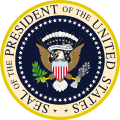
Back Heffings tydens die tweede Trump-administrasie Afrikaans الرسوم الجمركية في إدارة ترامب الثانية Arabic طاريفات ديال لولاية التانية د طرامپ ARY İkinci Tramp administrasiyasının tarif siyasəti Azerbaijani Тарыфная палітыка другой адміністрацыі Трампа Byelorussian দ্বিতীয় ট্রাম্প প্রশাসনের শুল্কারোপ Bengali/Bangla Cla za druhé vlády Donalda Trumpa Czech Aranceles en la segunda presidencia de Donald Trump Spanish Muga-zergak Trumpen bigarren agintaldian Basque تعرفهها در دور دوم ریاست جمهوری ترامپ Persian

| ||
|---|---|---|
|
Business and personal 45th and 47th President of the United States Tenure
Impeachments Legal proceedings  |
||
During his second presidency, United States president Donald Trump enacted a series of steep protective tariffs affecting nearly all goods imported into the United States. From January to April 2025, the average effective US tariff rate rose from 2.5% to an estimated 27%, the highest level in over a century.[2] Following policy rollbacks, the average effective tariff rate was 15.8% as of June 17, 2025.[3][4]
Trump raised steel and aluminum tariffs to 50%, introduced a 25% tariff on imported cars, and ordered investigations into pharmaceuticals, copper, and other sectors to support future tariffs. He also invoked unprecedented powers under the International Emergency Economic Powers Act (IEEPA) to impose broad, universal tariffs affecting all imports. Although federal courts ruled this use of the IEEPA unconstitutional, the decisions were stayed pending appeal, allowing the tariffs to remain in effect. Oral arguments on the appeals are scheduled for July 31, 2025.[5]
On April 2, 2025—a day he called "Liberation Day"—Trump invoked the IEEPA to announce "reciprocal tariffs" on all countries not subject to other sanctions. A universal 10% tariff took effect on April 5. Additional tariffs for 57 major trading partners were planned for April 9, but were suspended until July 8 following a stock market crash triggered by the tariffs. Trump also imposed 25% tariffs on Canada and Mexico under the IEEPA, but later exempted goods compliant with the United States–Mexico–Canada Agreement (USMCA). He escalated the China–United States trade war, with baseline US tariffs on Chinese goods peaking at 145% and Chinese tariffs on U.S. goods reaching 125%. Following a trade agreement, the US reduced its tariffs to 30% and China reduced to 10%. US tariffs on Chinese de minimis shipments were lowered to 54%. China also agreed to resume exports of critical rare earth elements it had curtailed in retaliation.
The Trump administration argues that its tariffs will promote domestic manufacturing, protect national security, and substitute for income taxes. The administration views trade deficits as inherently harmful, a stance economists criticized as a flawed understanding of trade.[6][7][8][9] The tariffs contributed to downgraded GDP growth projections by the US Federal Reserve,[10] the OECD,[11] and the World Bank.[12] In the first quarter of 2025, US firms and consumers raced to stockpile foreign goods before new tariffs took effect, causing imports to soar 41.3%.[13]
- ^
- "Posters displaying information on reciprocal tariffs in the James S. Brady Press Briefing Room of the White House in Washington, DC, US". The Irish Times. Bloomberg News. April 2, 2025. Archived from the original on April 11, 2025. Retrieved April 11, 2025.
- "In pictures: Trump signs executive order on global tariffs". The Irish Times. April 2, 2025. Archived from the original on April 2, 2025. Retrieved April 11, 2025.
- ^ Reddy, Sudeep (April 10, 2025). "Reality Check: What Trump's Supposed Retreat Really Means in a Historic Trade War". Politico.
- ^ "State of U.S. Tariffs". The Budget Lab at Yale. June 17, 2025.
- ^ Irwin, Neil (June 5, 2025). "Trump's incredibly volatile tariff landscape, in one chart". Axios. Retrieved June 16, 2025.
- ^ Fechner, Inga. "US tariffs here to stay, trade deals 'largely symbolic'". ING Think. Retrieved June 16, 2025.
- ^ Bryan Mena; Alicia Wallace (April 5, 2025). "Trump's 'reciprocal' tariffs aren't quite what they seem. Here's the real story". CNN. Retrieved April 8, 2025.
- ^ Schneid, Rebecca (April 4, 2025). "Why Economists Are Horrified by Trump's Tariff Math". Time. Retrieved April 4, 2025.
- ^ Weissmann, Jordan (April 6, 2025). "The White House cited these economists to justify its tariffs. They aren't thrilled". Yahoo Finance. Archived from the original on April 5, 2025. Retrieved April 6, 2025.
- ^ Neiman, Brent (April 7, 2025). "Why Trump's Tariff Math Is a Joke". Opinion. The New York Times. ISSN 0362-4331. Retrieved April 7, 2025.
- ^ Jones, Callum (March 19, 2025). "Federal Reserve cuts US economic growth outlook amid Trump tariffs". The Guardian. ISSN 0261-3077. Retrieved June 16, 2025.
- ^ Kiderlin, Sophie (June 3, 2025). "U.S. growth forecast cut sharply by OECD as Trump tariffs sour global outlook". CNBC. Retrieved June 16, 2025.
- ^ Kiderlin, Sophie (June 10, 2025). "World Bank sharply cuts global growth outlook on trade turbulence". CNBC. Retrieved June 16, 2025.
- ^ Cox, Jeff (April 30, 2025). "U.S. economy shrank 0.3% in the first quarter as Trump policy uncertainty weighed on businesses". CNBC. Retrieved June 16, 2025.
© MMXXIII Rich X Search. We shall prevail. All rights reserved. Rich X Search

